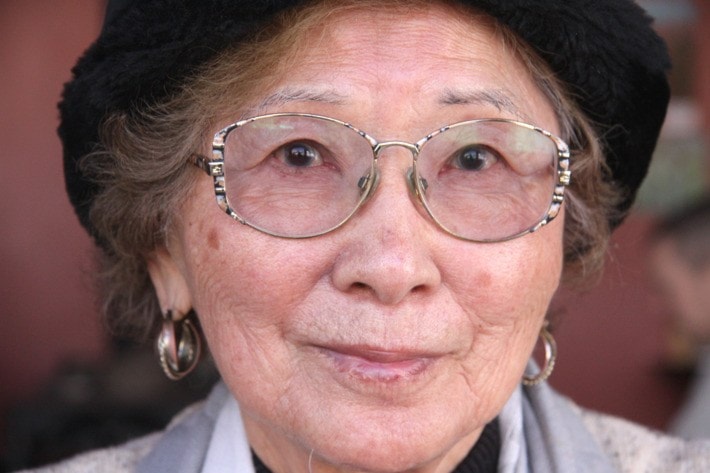Ninth in a series of pioneer profiles
To say Kaslo’s Aya Higashi was a popular teacher would be an understatement.
Old students invite her to weddings and anniversaries. She’s held their children. They packed the gym for her retirement party. And she swears she remembers them all.
Her popularity probably had to do with her egalitarian approach: she never played favourites, treating everyone equally.
“Sometimes former students say ‘We were bad kids, weren’t we?’ I never knew a bad kid. In 33 years of teaching, I never yelled at a kid nor strapped nor shook them,” she says. “My kids, I hug them.”
When she encountered several in the grocery store recently, they clogged up the aisle embracing. Another is now a 65-year-old grandfather. The generation gap has long since closed, and she considers them all friends, insisting they call her by her first name.
Higashi, 92, is the only Japanese Canadian still in Kaslo, which results in many requests to speak to tour groups, schools, and visitors. Reticent at first, “in case I said the wrong thing,” she has since become more comfortable in the spotlight.
She still finds the attention slightly embarrassing, but takes pride in being an ambassador for the village. Walking down Front Street, she is recognized and greeted by nearly everyone.
“It’s an honour to be known but also a heavy weight,” she says. “I have to be a good person. I can’t make a mistake. It’s a big responsibility.”
Born in Campbell River to Kiyomatsu and Kane Atagi, Aya grew up on Quadra Island, where her father was a boat builder. They later moved to Vancouver, where she graduated high school at 16. She wanted to go into either medicine or education, and took pre-med courses while working at a doctor’s office. Then the war changed everything.
During the internment years, her family lived in an abandoned house in Kaslo, minus her father, who was working in the Crowsnest Pass. They didn’t see him again for years.
That first winter was so cold, Kaslo Bay froze.
Aya had never lived near other Nikkei families, and discovered her spoken Japanese was formal and stilted compared to her contemporaries — she didn’t know any slang.
At 19, she began teaching in the Kaslo internment school in the Giegerich block, which is still standing. Later, she became principal of the Popoff farm school, near Slocan City.
After the war, she attended Vancouver Normal School to obtain her BC teaching certificate, and despite many offers to go elsewhere, returned to Kaslo to fulfull a promise to the local principal. She taught mostly senior high, specializing in commerce and home economics.
In 1949, she married Buck Higashi, a catcher on the Slocan baseball team whose kindness impressed her. They were together 59 years. They had no children of their own, but Aya considers all her students to be her kids.
Upon her retirement in 1986, they were going to move to the coast, but she soon discovered she couldn’t do it. Buck told her: “I wondered when you would realize that.”
“I could never leave Kaslo,” Aya says. “Kaslo is my family.”
By that time, they were the only Nikkei left in town — only two other families stayed after the war. Aya has a younger brother in Nelson and an older sister in Japan.
Despite the circumstances that brought her to Kaslo, she wouldn’t change what happened.
“I was raised on ‘It can’t be helped.’ You make the best of what you get,“ she says. “I accepted what came. I couldn’t have a better life than I have here.”
Previous installments in this series
